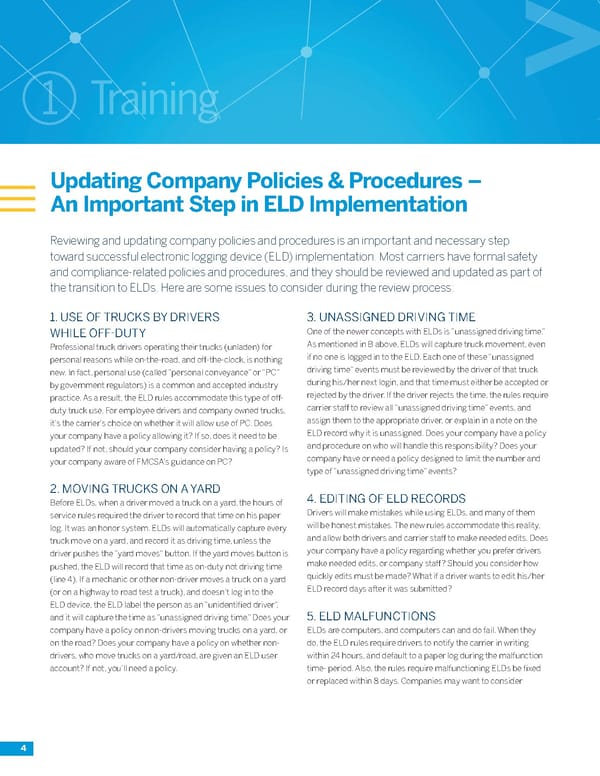4 1. USE OF TRUCKS BY DRIVERS WHILE OFF-DUTY Professional truck drivers operating their trucks (unladen) for personal reasons while on-the-road, and off-the-clock, is nothing new. In fact, personal use (called “personal conveyance” or “PC” by government regulators) is a common and accepted industry practice. As a result, the ELD rules accommodate this type of off- duty truck use. For employee drivers and company owned trucks, it’s the carrier’s choice on whether it will allow use of PC. Does your company have a policy allowing it? If so, does it need to be updated? If not, should your company consider having a policy? Is your company aware of FMCSA’s guidance on PC? 2. MOVING TRUCKS ON A YARD Before ELDs, when a driver moved a truck on a yard, the hours of service rules required the driver to record that time on his paper log. It was an honor system. ELDs will automatically capture every truck move on a yard, and record it as driving time, unless the driver pushes the “yard moves” button. If the yard moves button is pushed, the ELD will record that time as on-duty not driving time (line 4). If a mechanic or other non-driver moves a truck on a yard (or on a highway to road test a truck), and doesn’t log in to the ELD device, the ELD label the person as an “unidentified driver”, and it will capture the time as “unassigned driving time.” Does your company have a policy on non-drivers moving trucks on a yard, or on the road? Does your company have a policy on whether non- drivers, who move trucks on a yard/road, are given an ELD user account? If not, you’ll need a policy. 3. UNASSIGNED DRIVING TIME One of the newer concepts with ELDs is “unassigned driving time.” As mentioned in B above, ELDs will capture truck movement, even if no one is logged in to the ELD. Each one of these “unassigned driving time” events must be reviewed by the driver of that truck during his/her next login, and that time must either be accepted or rejected by the driver. If the driver rejects the time, the rules require carrier staff to review all “unassigned driving time” events, and assign them to the appropriate driver, or explain in a note on the ELD record why it is unassigned. Does your company have a policy and procedure on who will handle this responsibility? Does your company have or need a policy designed to limit the number and type of “unassigned driving time” events? 4. EDITING OF ELD RECORDS Drivers will make mistakes while using ELDs, and many of them will be honest mistakes. The new rules accommodate this reality, and allow both drivers and carrier staff to make needed edits. Does your company have a policy regarding whether you prefer drivers make needed edits, or company staff? Should you consider how quickly edits must be made? What if a driver wants to edit his/her ELD record days after it was submitted? 5. ELD MALFUNCTIONS ELDs are computers, and computers can and do fail. When they do, the ELD rules require drivers to notify the carrier in writing within 24 hours, and default to a paper log during the malfunction time- period. Also, the rules require malfunctioning ELDs be fixed or replaced within 8 days. Companies may want to consider Reviewing and updating company policies and procedures is an important and necessary step toward successful electronic logging device (ELD) implementation. Most carriers have formal safety and compliance-related policies and procedures, and they should be reviewed and updated as part of the transition to ELDs. Here are some issues to consider during the review process: 1 Training Updating Company Policies & Procedures – An Important Step in ELD Implementation
 Roadmap to the ELD Mandate Page 3 Page 5
Roadmap to the ELD Mandate Page 3 Page 5